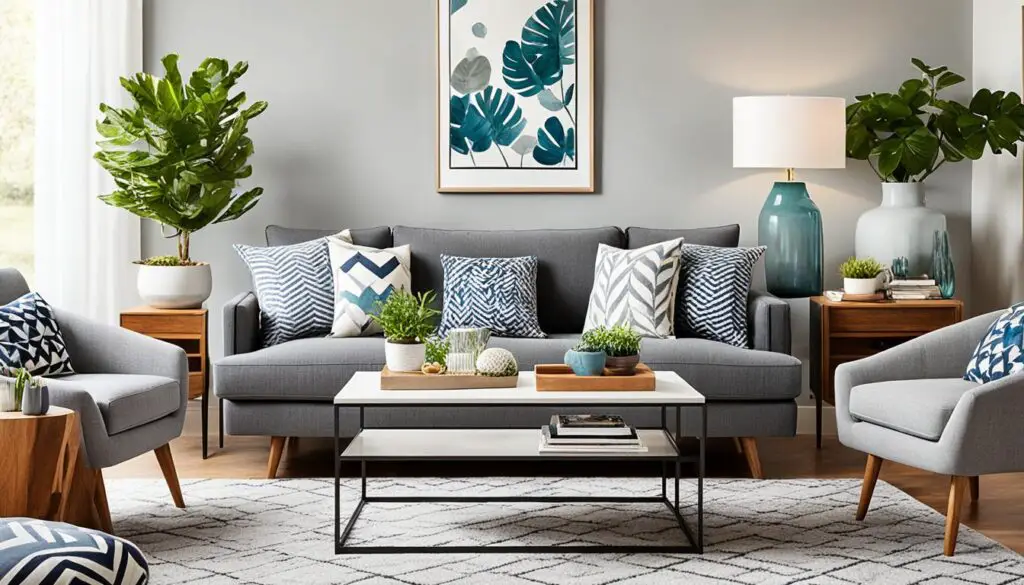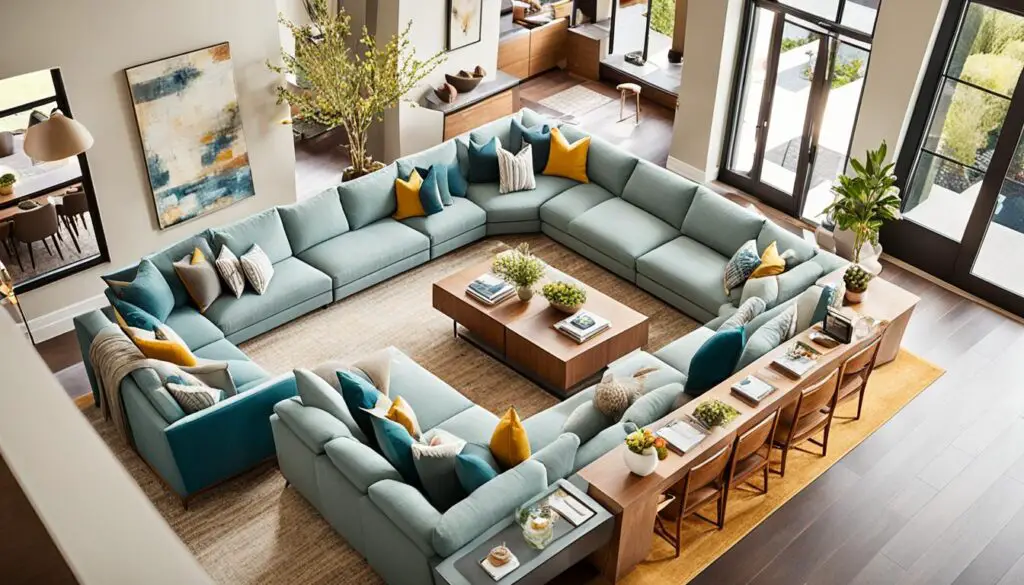
Your living room is a key spot to show off your style and relax with family and friends. It’s where you can make memories and enjoy quality time. With bold colors, plush furniture, and unique decor, you can make your living room special.
Check out these 20 living room designs ideas to inspire your own space. You’ll find everything from modern to rustic styles. Each idea is a chance to make your living room a place you’ll love spending time in.
Defining Your Living Room Style
Creating a visually captivating living room starts with defining your style. You might want a transitional, contemporary, rustic, or modern farmhouse look. Each style has its own way to change your space.
Transitional vs. Contemporary Living Room
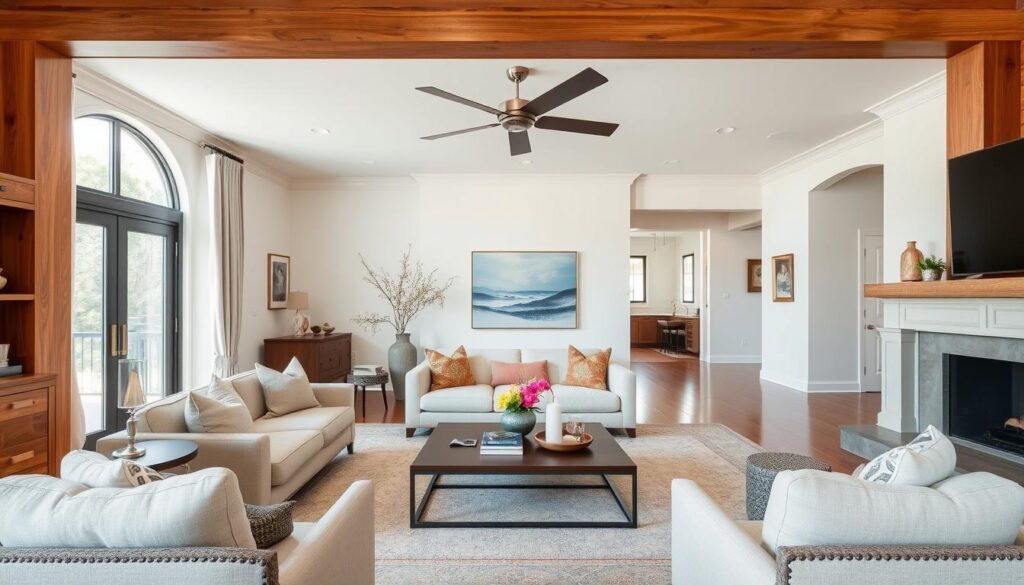
A transitional living room mixes traditional and modern for a timeless look. It has plush textiles, warm wood, and classic shapes with modern furniture and metallic touches. On the other hand, a contemporary living room goes for a minimalist feel. It uses sleek shapes, neutral colors, and empty spaces.
Rustic or Modern Farmhouse Living Room
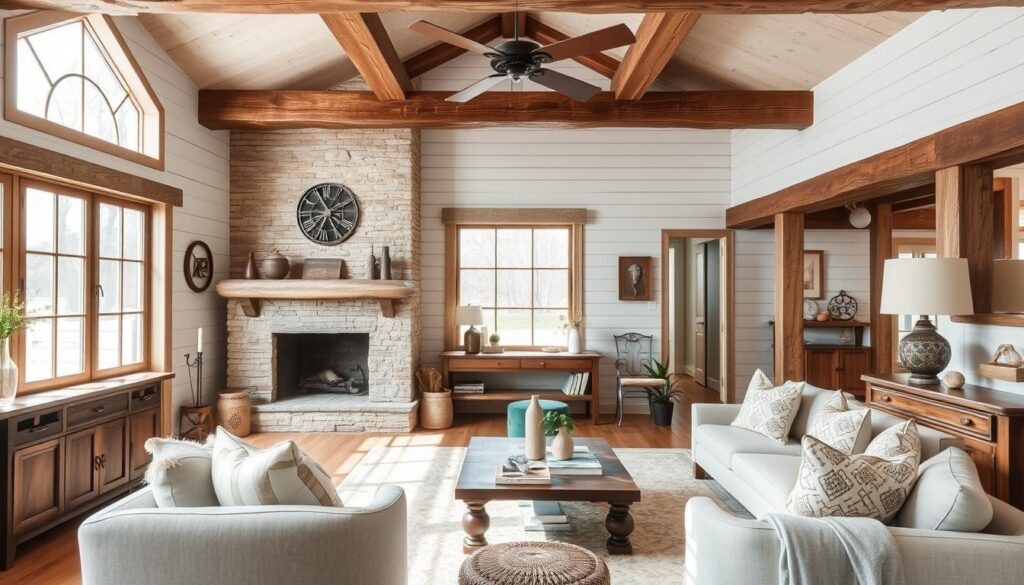
A rustic living room is cozy and inviting with natural materials like beams and stone fireplaces. A modern farmhouse living room adds a new twist to the classic look. It has white-washed wood, vintage decor, and light colors.
Choosing your interior design style means picking the mood and function you want in your living room. With a clear idea, you can pick the right furniture, textures, and decor for your dream space.
Furniture Arrangement for Functionality
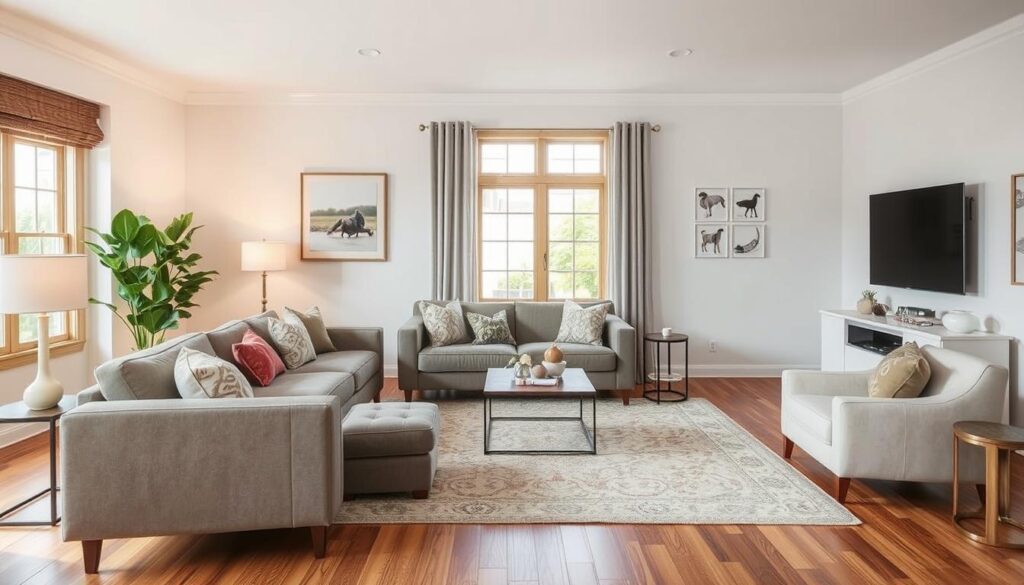
Designing your dream living room means focusing on furniture arrangement. It’s key to balance looks with practicality. By placing furniture thoughtfully, you make the room flow better, improve conversation, and boost functionality.
First, think about your living room’s size and layout. Pick furniture that fits well without making the room look cramped. Arrange seating, like sofas and chairs, to encourage talking and face-to-face chats.
Use the Homestyler app to try out different furniture setups and see how they look in your room. Measure your space before buying furniture to ensure a good fit. A 9’x12′ rug is often perfect for most living rooms.
- Set up furniture to create different areas, like a work or relaxing spot, a main area for guests, and a spot for displays.
- Choose furniture that does more than one job to make the most of your space.
- Area rugs can help define each area and add visual interest in an open layout.
- Try out various furniture setups to find the best fit for your room’s size and purpose.
By focusing on living room furniture arrangement, furniture placement, layout, and functionality, you can make a living room that looks great and works well. It will meet your specific needs and tastes.
Lighting to Set the Ambiance
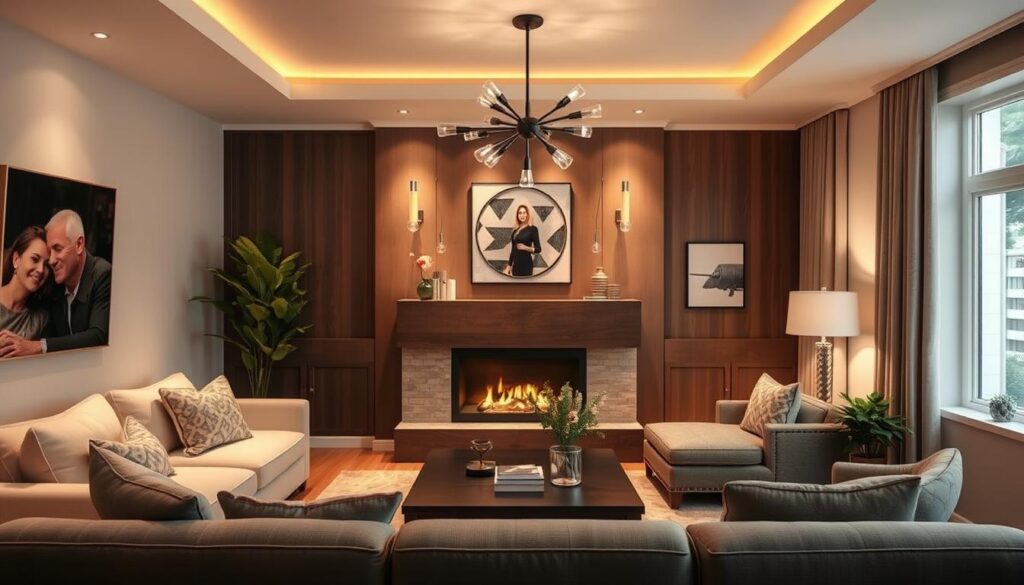
Creating the perfect living room vibe starts with smart lighting. Use layered lighting to mix ambient, task, and accent lights for a balanced look. Start with soft overhead lighting to set the mood. Then, add task lights for reading or working. Finally, use accent lights to highlight special features or decor, adding personality to the room.
Layering Different Light Sources
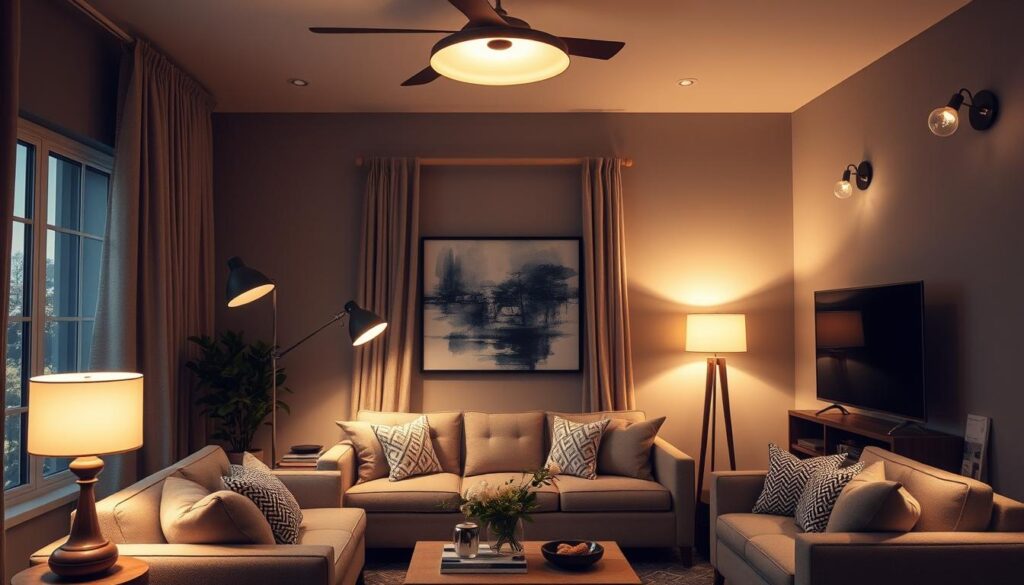
Using various light sources is crucial for the perfect living room feel. Mix ceiling lights, floor lamps, and wall sconces for a layered effect. Choose dimmable bulbs to adjust the light for different moods, from cozy to bright. Place lamps carefully to spread light evenly, avoiding dark spots.
Statement Lighting Fixtures

A standout lighting piece can change a living room’s look. From modern pendants to vintage chandeliers, the right fixture draws attention and adds drama. Look for materials and styles that match your decor, whether it’s modern or classic.
| Lighting Trend | Description | Examples |
|---|---|---|
| Metallic Finishes | Brass, gold, or silver fixtures add a touch of luxe and sophistication. | Sputnik chandeliers, globe pendants, and geometric wall sconces. |
| Organic Textures | Natural materials like rattan, wicker, and macrame create a warm, earthy vibe. | Woven pendant lights, feathery chandeliers, and textured wall fixtures. |
| Minimalist Designs | Clean lines, simple silhouettes, and muted tones offer a sleek, contemporary look. | Flush-mount ceiling lights, linear pendants, and streamlined table lamps. |
The right lighting can greatly enhance your living room’s ambiance and design.
20 living room designs ideas
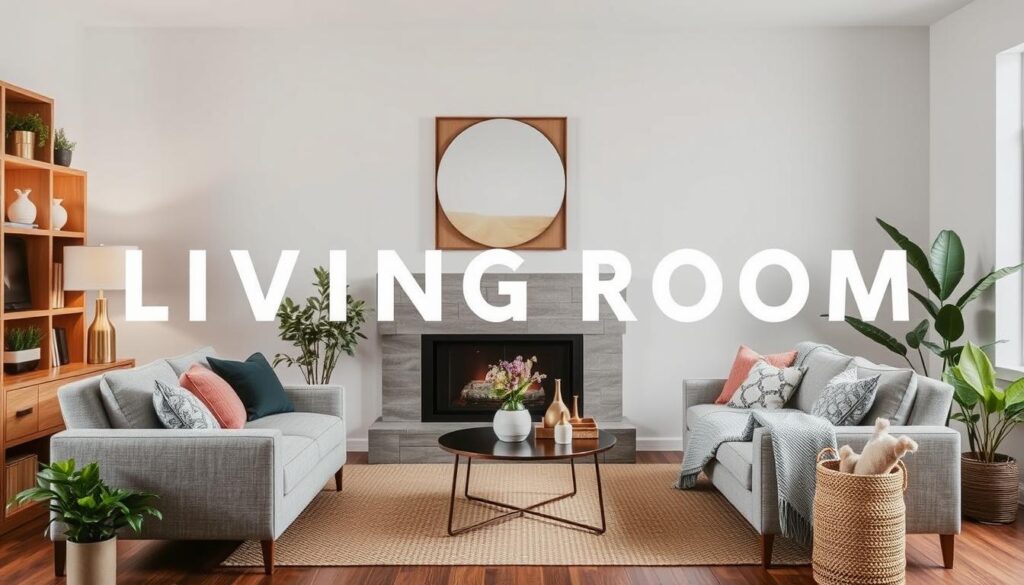
Creating a cozy living space starts with the right living room design ideas. We’ve gathered 20 stylish ways to refresh your living room. From modern to rustic, there’s something for everyone. Let’s explore these inspiring ideas together!
- Embrace a Transitional Style: Mix modern and traditional for a calm design. Choose soft colors and add handmade items for warmth.
- Go for a Contemporary Look: Use clean lines and simple furniture for a modern feel. Highlight your room’s features with modern pieces.
- Embrace Rustic Charm: Warm woods and natural textures make a cozy, farmhouse-style room. Add vintage or handmade items for a personal touch.
- Blend Modern and Traditional: Combine modern and traditional for a unique look. Use warm colors to make modern furniture cozy, and add materials like worn linen for an old-world feel.
- Create a Calming Oasis: Focus on simple, modern furniture and art for a peaceful room. Use rich colors to keep the space cohesive and relaxing.
| Design Style | Key Characteristics | Percentage of Designs |
|---|---|---|
| Transitional | Blend of modern and traditional elements, restrained color palette, warm and inviting | 75% |
| Contemporary | Clean lines, minimalist furniture, sophisticated art, highlighting architecture | 50% |
| Rustic | Warm wood tones, natural textures, earthy hues, vintage and handcrafted elements | 35% |
| Modern Farmhouse | Blend of modern and traditional, warm color palette, mix of materials | 30% |
| Minimalist Transitional | Sophisticated and simple modern furniture and art, mix of saturated colors | 20% |
These 20 living room design ideas provide a wide range of inspiration for your home. Whether you like transitional, contemporary, or rustic styles, there’s an idea here for you. Each design aims to make your living room inviting and functional.
Blending Textures and Patterns
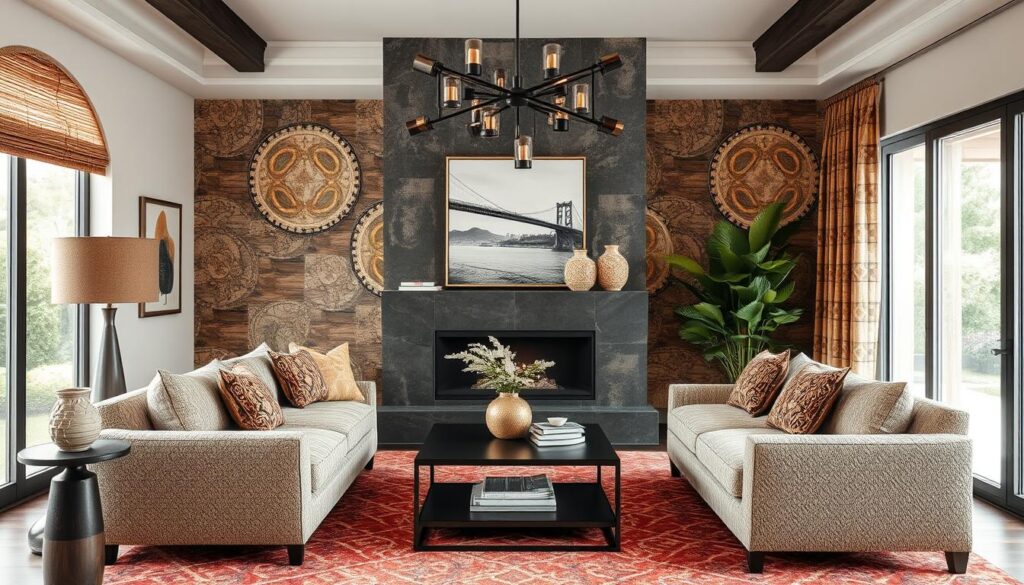
Making your living room look great means using textured fabrics and mixed materials. Adding different patterns and textures can make a big difference. It adds depth, personality, and a bit of luxury.
Mixing Textured Fabrics and Materials
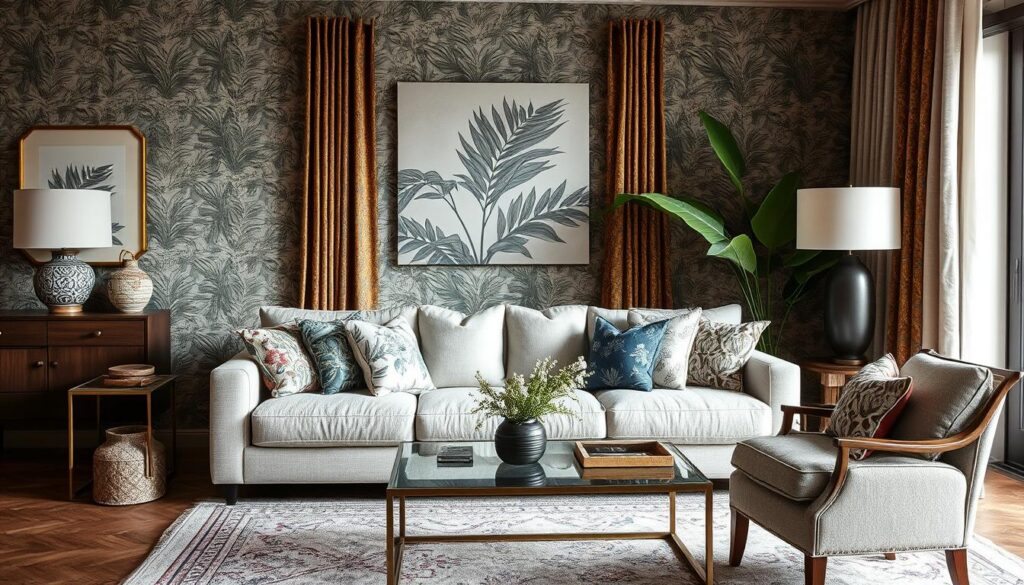
Begin with throw pillows and accessories to mix patterns and textures. Try pairing delicate floral prints with bold leaf patterns. Or, mix velvet cushions with patterned ones to boost your living room’s look and feel. Keep the colors the same but change the pattern sizes and intensity.
Try bigger textured items like curtains, rugs, and furniture. Use wood, metal, and glass together for interesting contrasts. Make sure to test fabrics and materials together before buying to match them well.
“Mixing patterns in home styling can create a vibrant and personalized look, with a touch of personality to the room.”
Add luxury with handmade Indian silk bed throws or mix velvet and leather textures. Think about how natural light changes the look of your materials and patterns during the day. This can make your design look better and more striking.
Blending textures and patterns well is all about balance. Try for a 70/30 mix, with most of the room looking similar and 30% with bold contrasts. This mix makes your living room look great and interesting.
Incorporating Natural Elements
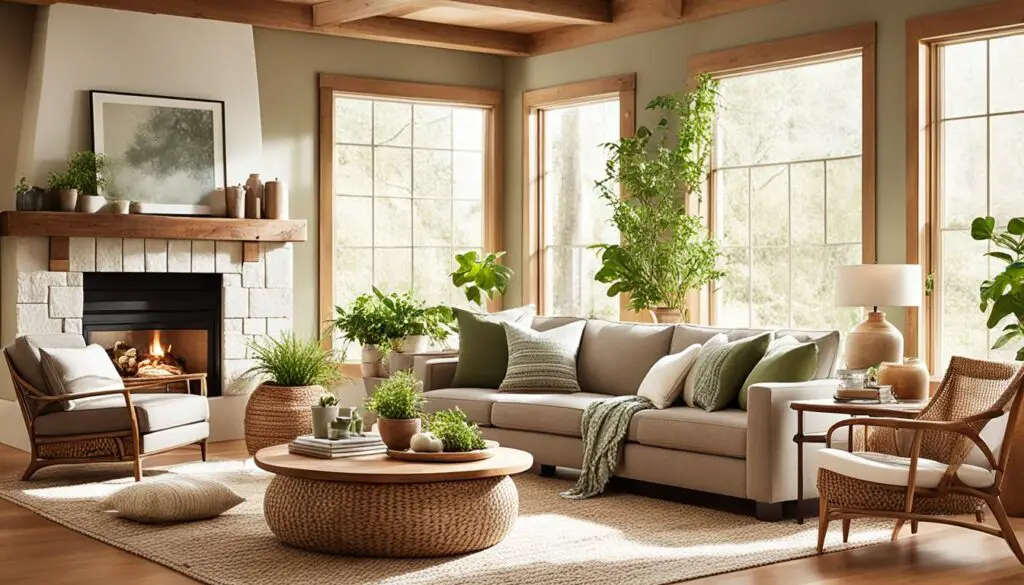
Creating a soothing living room means adding natural elements. This includes lush indoor plants and organic materials. These choices bring the outdoors into your home. Whether you like real plants or faux ones, they’re essential for a cozy living room.
80% of living room designs use a neutral color palette. This makes the space calm and connected to nature. All designs use natural materials like wood, adding warmth and organic beauty. Organic shapes also add a modern and elegant look.
Natural textures and organic decor are found in 50% of designs. This creates a cozy feel. Warm earth-tone colors are used in 40% of designs, making the space feel grounded and sophisticated.
Natural elements go beyond just colors and textures. 100% of designs include wood tones, adding texture and natural elements. Open shelving is seen in 20% of designs, perfect for showing off organic pottery and decor. And, decorating with branches is in 10% of designs, bringing the outdoors inside in a unique way.
Since we spend almost 90% of our time indoors, adding natural elements is key. By using biophilic design, we can make our living rooms beautiful and peaceful. This approach connects us with nature, making our homes a haven of tranquility and well-being.
| Natural Design Feature | Percentage of Living Room Designs Incorporating |
|---|---|
| Neutral color palette | 80% |
| Natural materials (e.g., wood) | 100% |
| Organic shapes | 70% |
| Clean lines | 60% |
| Combination of natural textures and organic modern decor | 50% |
| Warm earth-tone colors | 40% |
| Light and dark contrasts | 30% |
| Wood tones | 100% |
| Open shelving | 20% |
| Decorating with branches | 10% |
“Incorporating natural elements in interior design is a key aspect of biophilic design, which aims to merge nature with the indoor environment. By using natural materials, introducing greenery, and creating a connection to the outdoors, homeowners can enhance the overall living experience and promote a sense of well-being.”
Creating Focal Points
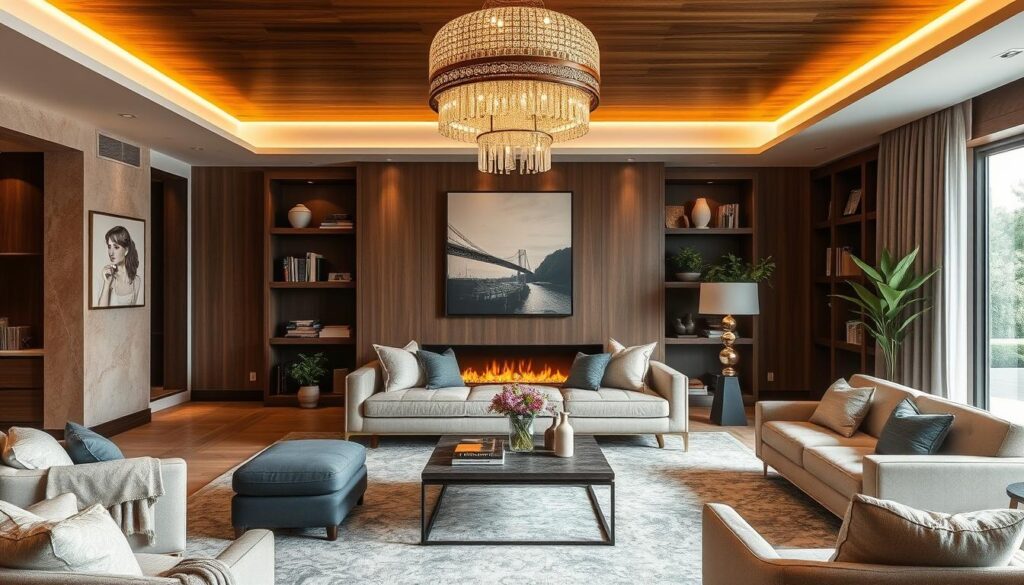
In interior design, placing focal points is key to a great living room. These elements grab the eye and pull attention. They can turn a big or small space into something special.
Accent Walls and Architectural Features
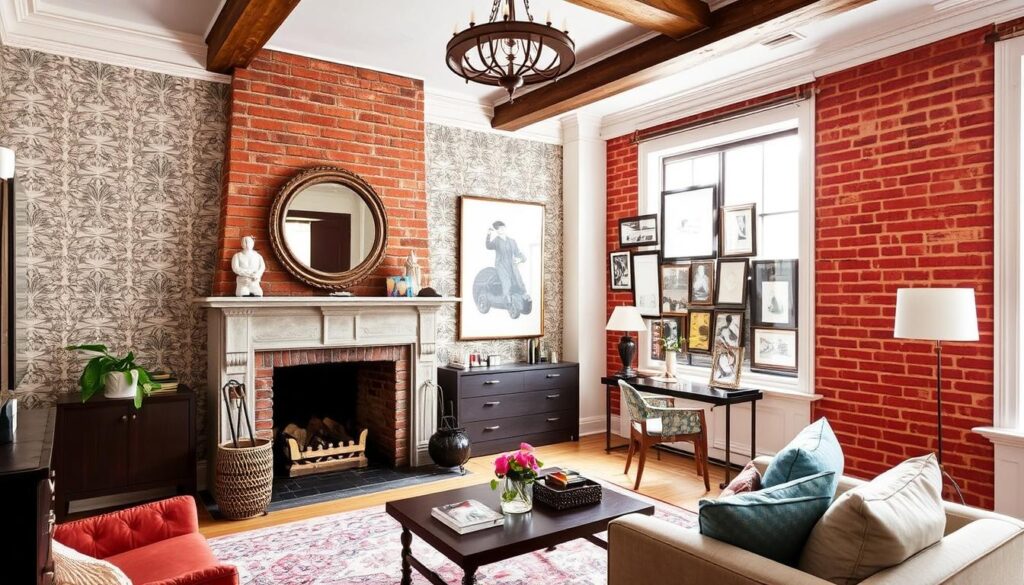
Accent walls and architectural features are great for focal points. Wallpapered walls, detailed moldings, or a big fireplace can make a room stand out. Designers balance these points by thinking about visual weight and contrast.
In a Brooklyn townhouse, the living room has three main focal points. There are rustic wood beams, an old stone mantel, and exposed brick walls. Together, they create a beautiful look that catches the eye.
In a London apartment, a bright red brick wall is the main focus. It’s matched with a gallery wall that adds more interest. Designers use textures and colors to make rooms look amazing and put together.
“Negative space, when used right, makes focal points stand out more and makes rooms feel bigger.”
Choosing a statement fireplace, a big feature wall, or a mix of elements is up to you. The goal is to balance these points so they work well together. This makes the living room engaging and fun to look at.
Maximizing Small Spaces

Maximizing space in small living rooms is key. It’s all about smart furniture choices and using space-saving ideas. With the right design, even tiny rooms can feel big and welcoming.
Space-Saving Furniture and Layouts
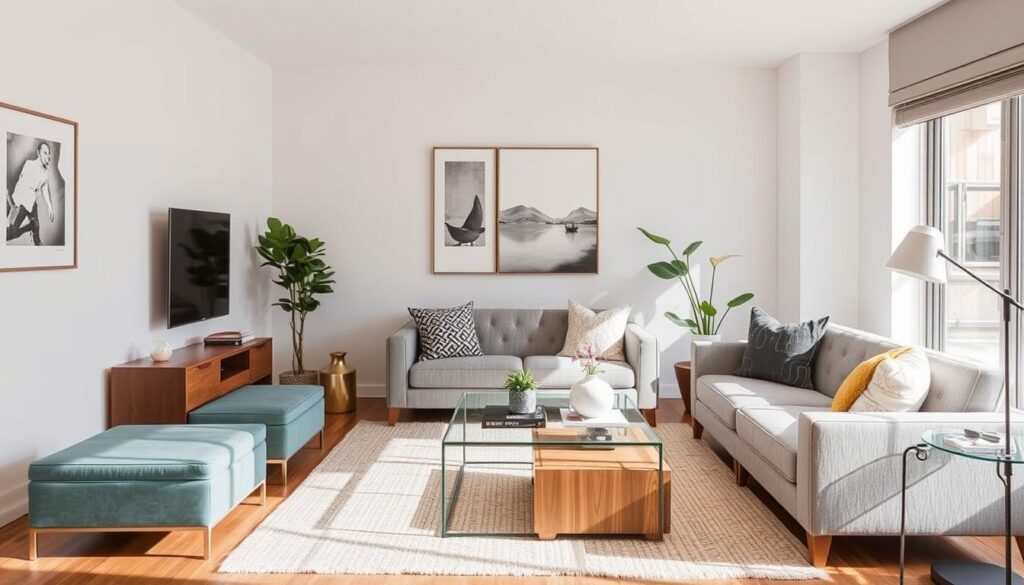
Choosing the right furniture is crucial for small living rooms. Go for pieces that do more than one job, like ottomans that are also coffee tables. Pick sleek designs that fit well without taking up too much room. Make sure furniture is arranged to keep paths clear and easy to move through.
- Utilize multi-purpose furniture like ottomans and storage benches to maximize functionality
- Select slim, low-profile sofas and chairs to avoid overcrowding the room
- Arrange furniture in a way that keeps walkways open and promotes easy movement
- Incorporate clear or lightweight pieces like acrylic tables to maintain an airy, spacious feel
The way you arrange the room can also make it look bigger. Use mirrors to bounce light and add depth. Light-colored walls can also make the room feel larger.
| Design Strategies | Percentage of Small Living Room Ideas |
|---|---|
| Incorporating multi-functional furniture | 30% |
| Selecting furniture proportional to room size | 60% |
| Using mirrors to create optical illusion of larger space | 35% |
| Incorporating clear or lightweight furniture pieces | 25% |
| Strategically using color schemes to visually expand the space | 40% |
With smart furniture and layout choices, small living rooms can become cozy and inviting. The right design tricks can turn a tiny space into a warm and welcoming spot.
Open Floor Plan Living Rooms

Open floor plans make rooms feel airy and spacious. But, they need careful planning to work well. The secret is arranging furniture smartly and adding special spots for each area.
Begin by setting up your furniture in cozy groups. Use a standout piece, like a rug under the couch or a bright chandelier over the dining area. This makes each part of the room clear.
Using the same flooring and ceiling helps tie the room together. Add lights in each area for better visibility. Colors that match and built-in bookshelves also make the room look connected.
No matter your style, an open floor plan lets you express yourself. Add unique pieces, art, and accessories that show off your taste.
Open-concept living makes your home welcoming and useful. With the right mix of zones, furniture, and personal touches, your living room will be the home’s center.
Statement Pieces and Accents

Adding eye-catching elements to your living room can make it more lively and beautiful. You can choose from bold artwork, stunning mirrors, or unique decorative accents. These pieces can change the look and feel of your space completely.
Artwork, Mirrors, and Decor Items
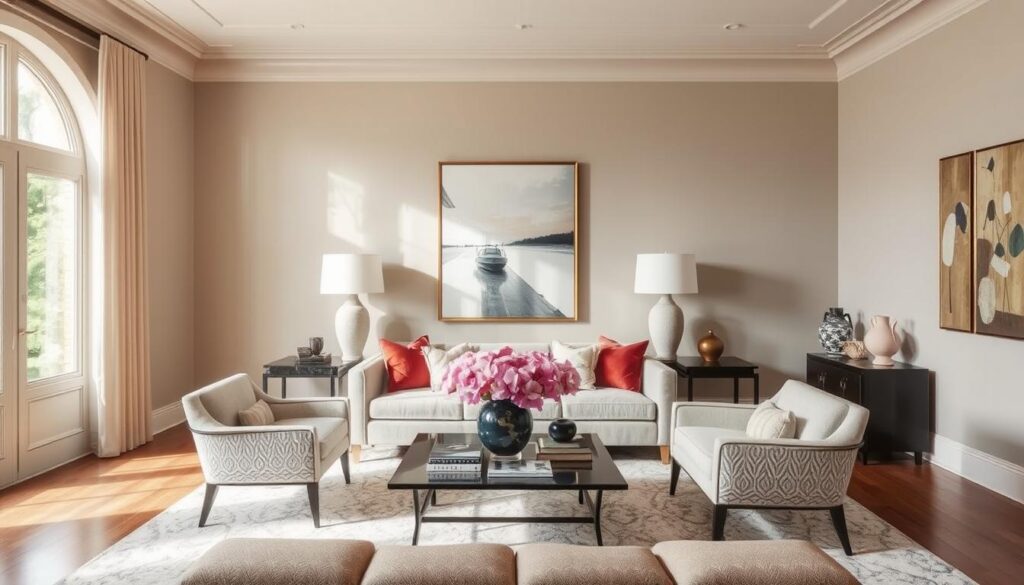
There are many ways to express your style with art. You can use big canvases or create a gallery wall. Mirrors not only make rooms look bigger but also bring in more light. And, decorative accents like vases and sculptures add a personal touch.
When setting up your living room, feel free to mix different items. Combining bold statement pieces with softer decor creates a unique and interesting space.
“Decorating is not about making stage sets, it’s not about making pretty pictures for the magazines, it’s really about creating a quality of life, a beauty that nourishes the soul.” – Albert Hadley
It’s important to balance boldness with comfort in your living room. With the right mix of artwork, mirrors, and decorative accents, your living room can become a stylish and cozy retreat.
Monochromatic Color Schemes

If you prefer subtle colors, a monochromatic color scheme is great for your living room. It uses different tonal colors of the same hue for a unified look. Paint the walls, ceiling, and built-ins the same color for a clean base.
Then, pick furniture in various shades of the same color to add depth. Use throw pillows, plants, and decor to finish the look. This approach makes a minimalist design that looks striking and chic.
| Color Scheme | Living Room Design Inspiration |
|---|---|
| Neutral Monochrome | Cozy living room featuring shades of gray and white, with touches of natural wood for warmth. |
| Soft Blue Monochrome | Serene living space using different tints and tones of a soothing blue hue. |
| Earthy Monochrome | Rustic-inspired living room with a neutral palette of beige, brown, and tan tones. |
For a great monochromatic color scheme, mix textures and materials. Try different shades, finishes, and accents. This makes your living room stylish and unified.
Indoor-Outdoor Living Room Connection
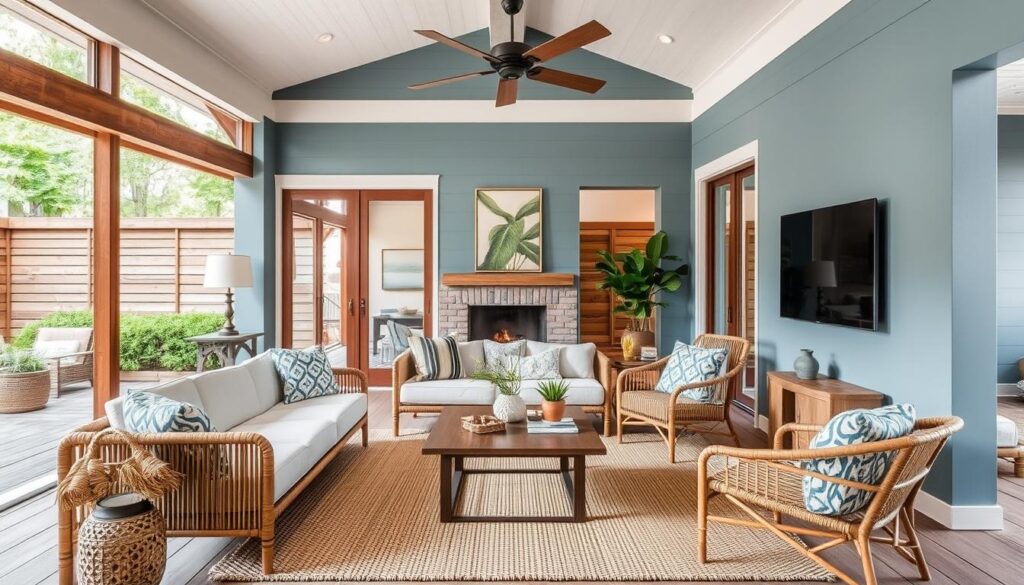
If you live in a place where outdoor living is possible, make the most of it. Create a cohesive design between your indoor and outdoor areas. Use the same color palette in both spaces for a smooth transition. Adding nature-inspired elements like a jute rug or bamboo chairs can also enhance the indoor-outdoor living feel.
Many designs in the [https://houseandhome.com/gallery/13-incredible-indoor-outdoor-spaces/] article show how to connect indoor and outdoor spaces. Features like sliding glass doors and custom fire pits help create a unified living area.
| Design Element | Description |
|---|---|
| Aluminum Louvers | Adjustable panels for airflow and light |
| Travertine Floors | Natural stone that flows from inside to outside |
| Reconstituted Wood Veneer Panels | Wood products that look and feel like real wood |
| Custom Fire Pits and Dipping Pools | Features that make outdoor living special |
The article shows homes in various places, from beaches to mountains. Each has its own way to make indoor-outdoor living work well. Whether it’s by the sea or in the woods, the goal is to bring nature inside and make moving between spaces easy.
“The designs aim to blend the best of both worlds, offering panoramic views of natural surroundings while providing a cozy and airy atmosphere for relaxing or entertaining seamlessly between indoor and outdoor spaces.”
Incorporating Personal Interests

When designing your personalized living room, think about adding things that show off your unique hobbies and interests. This is where you’ll relax and unwind the most. Adding custom design elements that match your passions makes your living space truly personalized and enjoyable.
If you love to read, consider a wall of built-in bookshelves for your books. Movie fans might want a big screen TV and surround sound for a home theater. Music lovers could have a spot for their vinyl records and turntable, adding a musical vibe.
Don’t hesitate to be creative and think differently. Add your favorite art, collectibles, or a cozy spot for pets. The goal is to make your living room mirror your personal style and what makes you happy. This way, your space will look great and feel truly special and welcoming.
“Your home should tell the story of who you are, and be a collection of what you love.”
More Living Room Designs Ideas
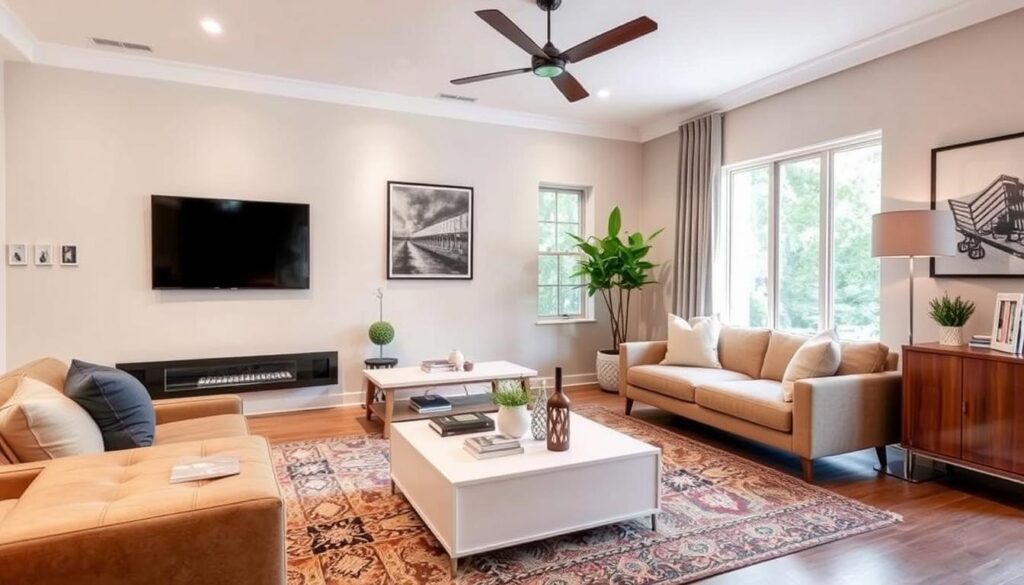
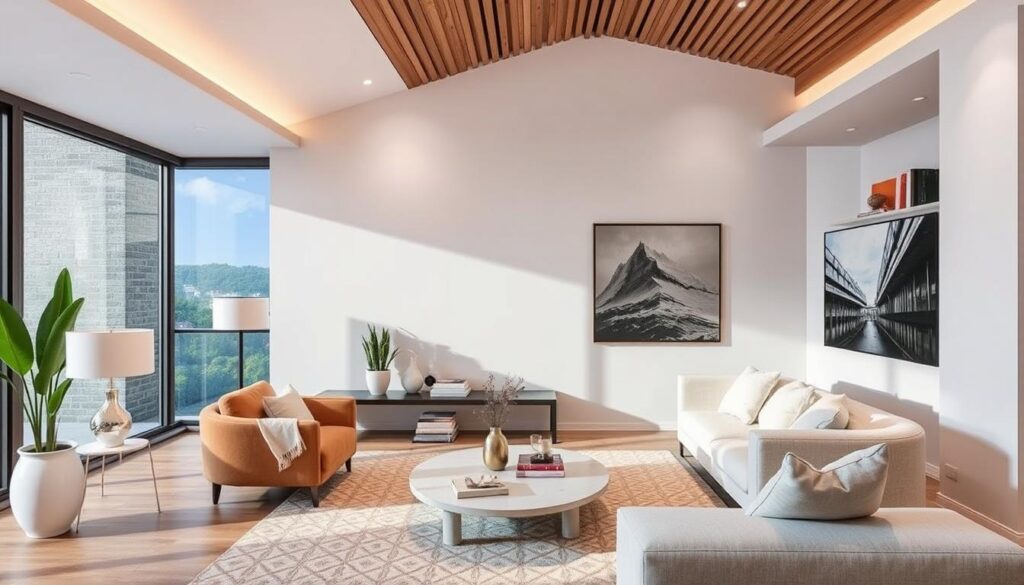
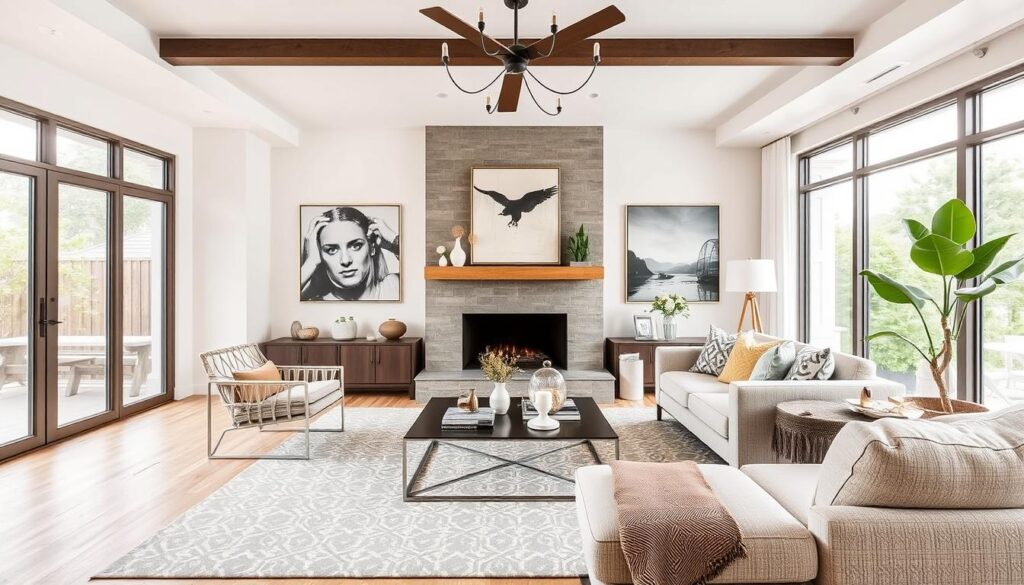
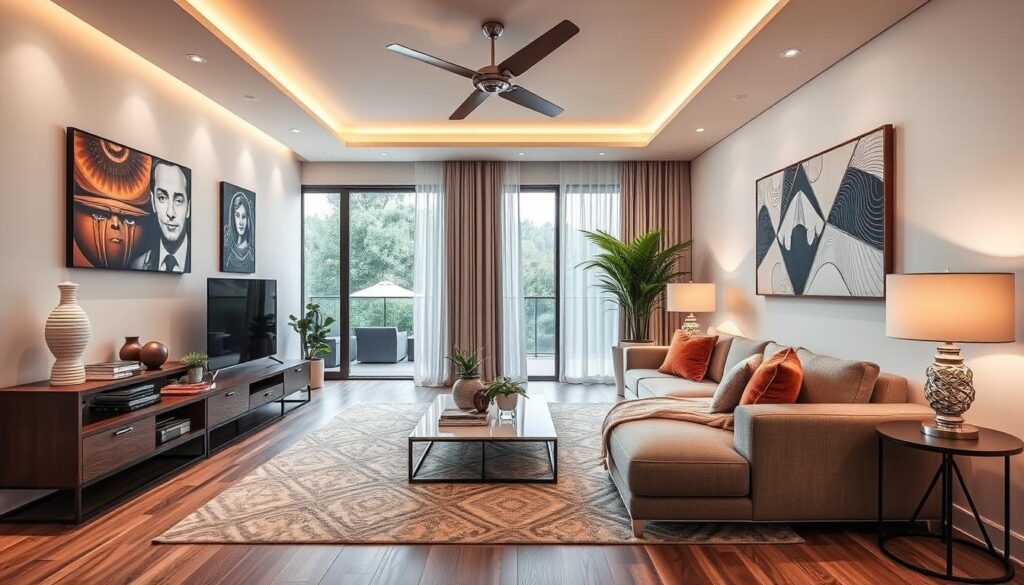
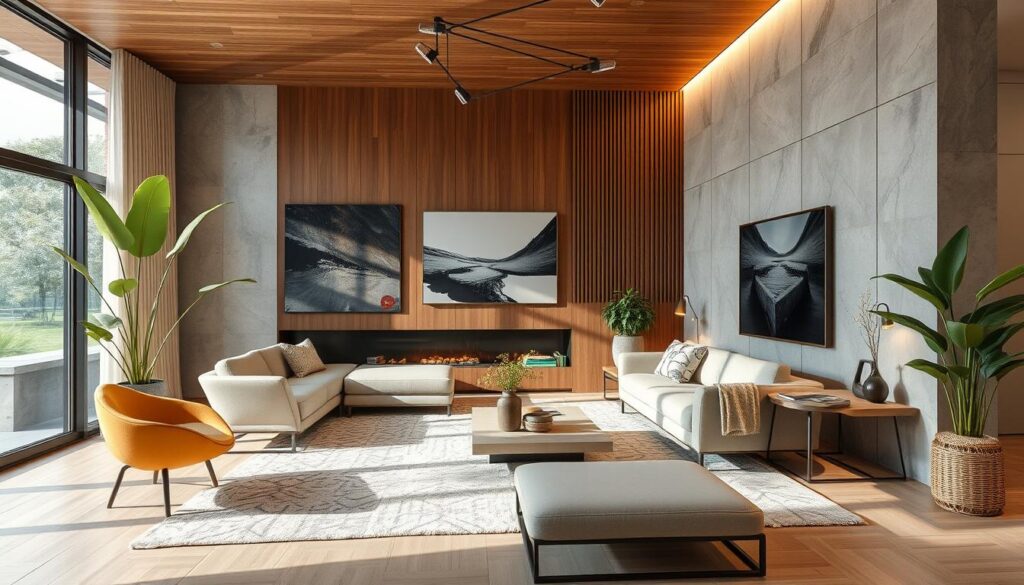
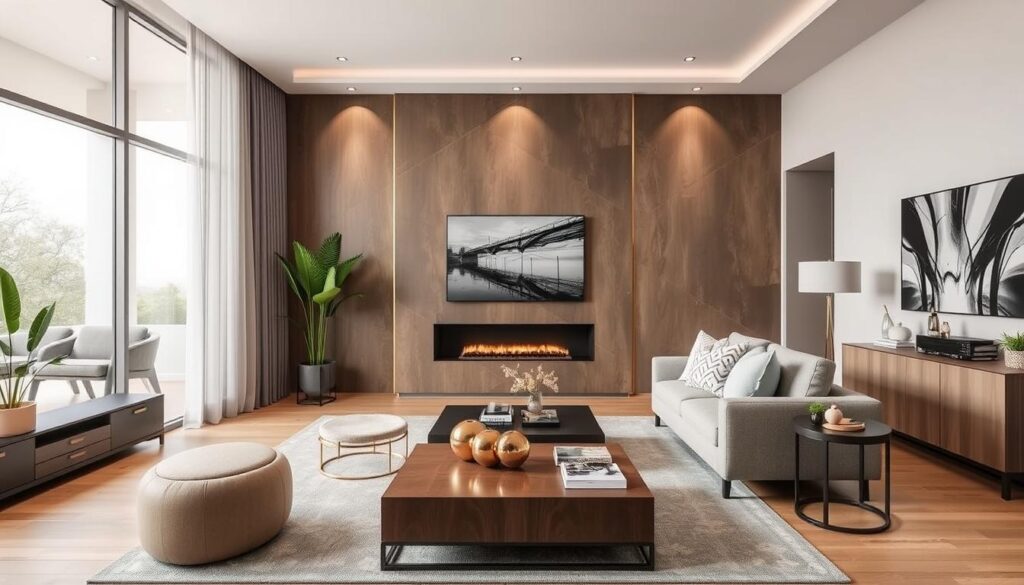
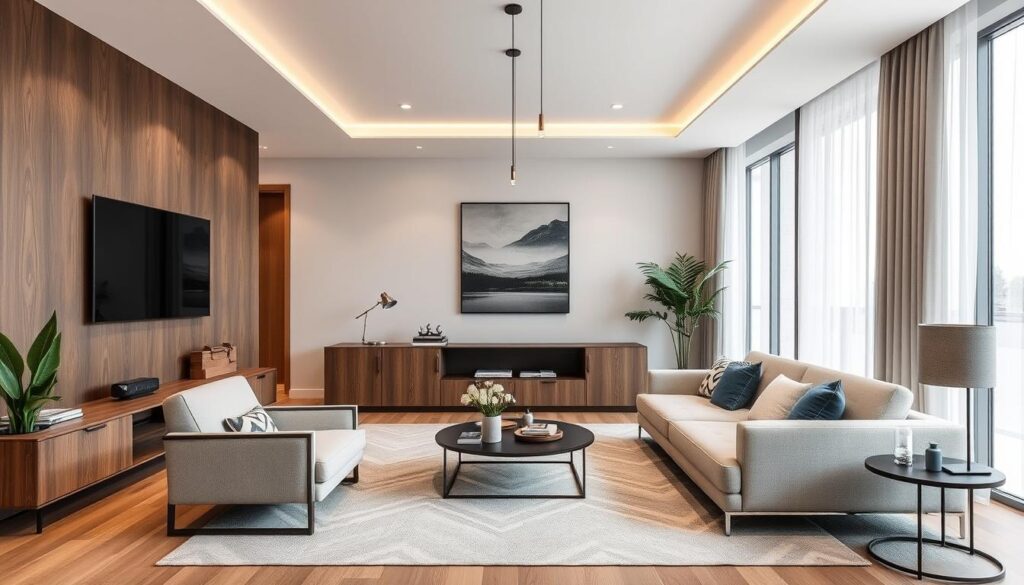
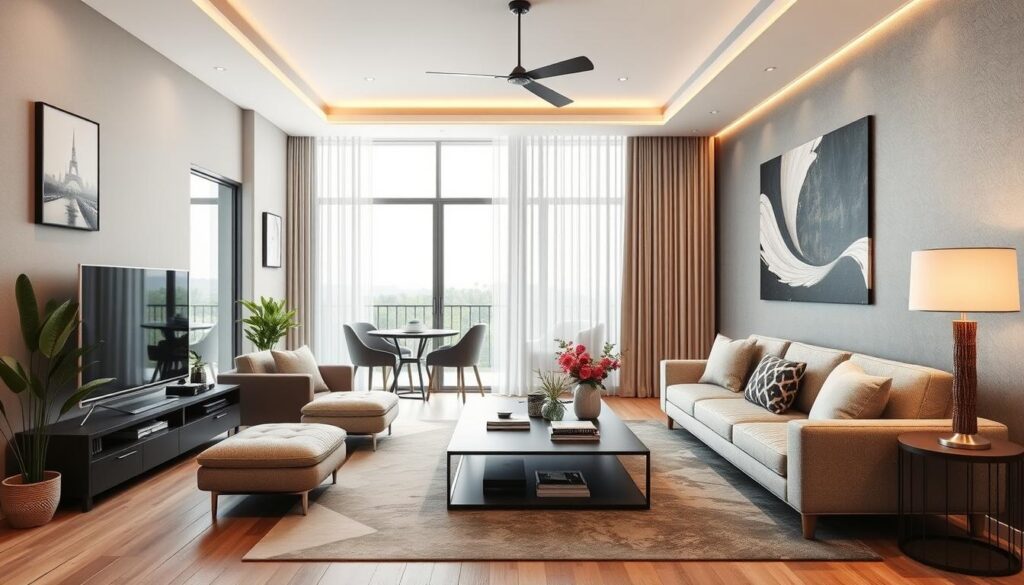
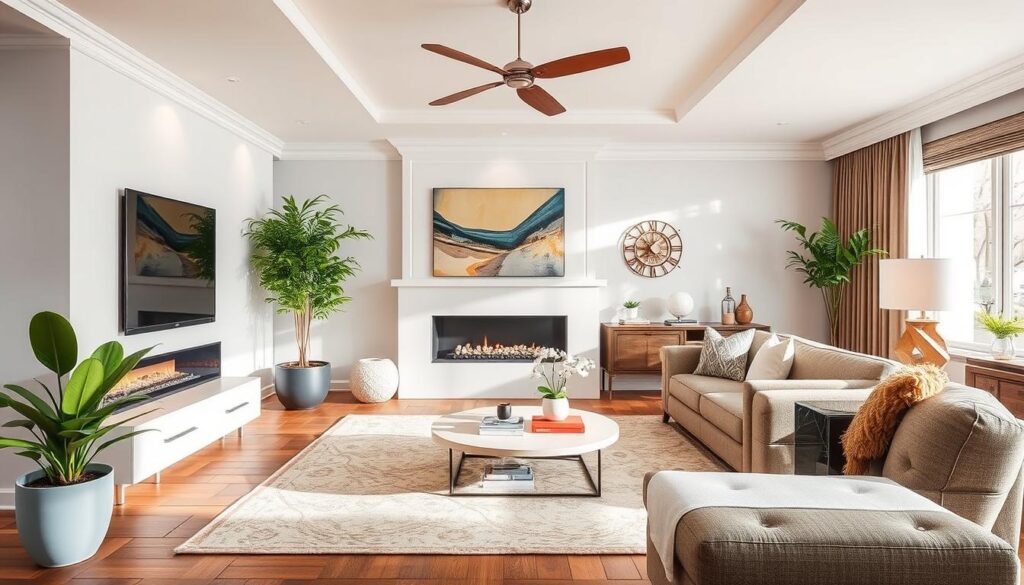
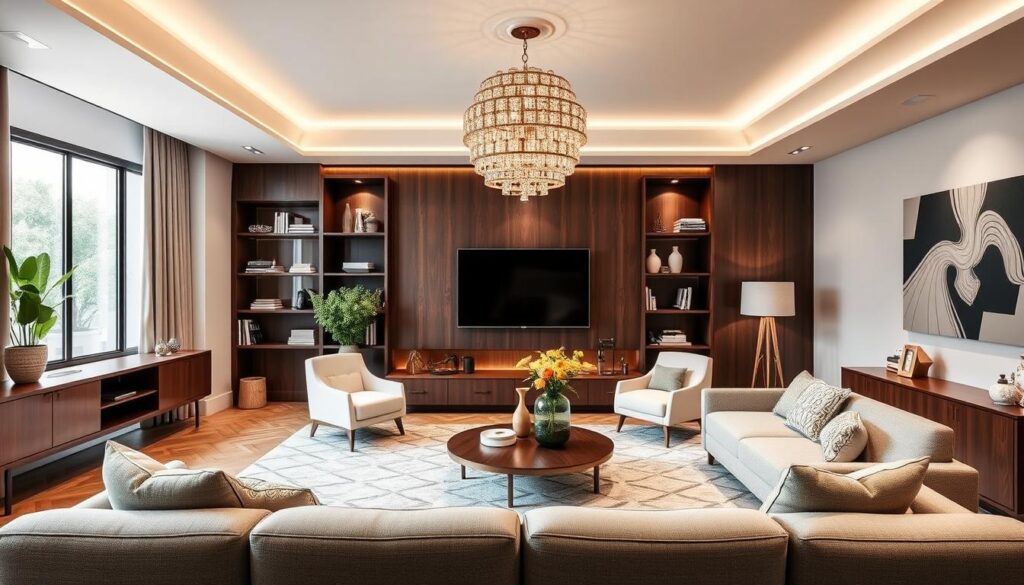
Conclusion
Designing your living room can be a fun and rewarding task. This guide has shown you 20 different ideas to inspire you. From modern to rustic styles, there’s something for everyone.
Think about how you want your furniture arranged and the lighting you need. Using different textures, patterns, and natural elements can make your space look great and work well.
If you have a small or big living room, there are tips to make the most of it. Adding statement pieces and choosing the right colors can make your home feel like a sanctuary. The goal is to balance style and function, showing off your unique taste.
Don’t be afraid to try new ideas and trends in your living room design. Stick to what you like and adjust the suggestions to fit your needs. This way, your living room will be both beautiful and a place where you and your loved ones can relax and have fun.
FAQ
What are some key considerations for planning a living room design?
When planning a living room design, start by defining what you want the room to do and how you want it to look. Think about the room’s size and shape. Also, consider how you’ll use the space to pick the right furniture and layout. This ensures everything fits well and makes the room a great place for hanging out.
How can lighting elevate a living room design?
Using different types of light can really change a living room’s feel. Add ambient, task, and accent lighting to create a unique atmosphere. Also, choose lighting fixtures that stand out to add to your design.
What are some ways to incorporate texture and visual interest?
Mixing different textures and patterns can make a living room lively and inviting. Try combining soft velvet sofas with rough wood coffee tables and chunky rugs. This mix of textures adds depth and interest.
How can natural elements enhance a living room design?
Adding plants, real or fake, can brighten up a room and add texture. Elements like driftwood or jute can also bring in a natural feel. These touches help create a space that feels connected to nature.
What are some tips for maximizing small living room spaces?
To make a small living room look bigger, use mirrors and curtains that go all the way up to the ceiling. A focal point can also draw the eye away from the room’s size. Choosing the right furniture size and arrangement is key to keeping the room open and functional.
How can an open floor plan be designed effectively?
In an open floor plan, set up different areas for sitting, dining, and other activities. Use furniture and rugs to define these spaces. Adding statement lighting can also help keep the room feeling connected and stylish.
What are some ways to personalize a living room design?
Add personal touches that show off your interests, like built-in bookshelves or a home theater. These unique features make your living room truly yours and suited to your lifestyle.

